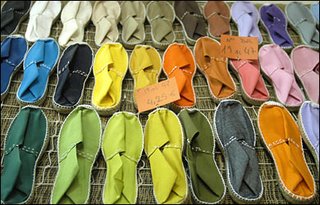
It's espadrille season again (or as a sign I passed today, clearing shooting—if perhaps not very effectively—for the English-speaking market says: "Time for Spadrilles from Spain." Not far from our apartment, the crowds are again gathering around what I think must be Madrid's most popular footwear store, Casa Hernanz. I
wrote about the shop about a year ago, but what were in my opinion the best parts got cut out. So I thought I'd print the original here:
Around the first of May last year, long lines began forming outside a little shop just off Madrid’s Plaza Mayor. I had walked past it for months but never really noticed the place before: a non-descript awning reading “Casa Hernanz” and a pair of smudged display windows were the only signs of commerce. But now, suddenly, an ever-present trail of people led out from the door. Morning and night, every day but Sunday, lines snaked around the corner. What were they after? Was this a secret outlet for U2 tickets? Was someone handing out free hams?
Casa Hernanz, it turns out, makes espadrilles. A thousand stores in the city sell these homely, rope-soled shoes, but there is only one Casa Hernanz, where the long wooden counter dates to the nineteenth century and the shoes are made by hand. Come summer—a season which, according to local fashion norms, calls for rope-soled footwear—it is the place for madrileños to buy their authentic espadrilles.
The Hernanz family has been in business for five generations. Today, brothers Jesus and Antonio still make the basic kind of espadrille—two pieces of sturdy cotton sewn to a flat hemp sole—by hand, although they have improved on the original model by gluing a piece of rubber to the sole in order to make the shoe more durable. They also make truly traditional pairs—Jesus calls them “artisanal” –whose soles are unadorned and which are sewn with hemp instead of cotton.
Lightweight and inexpensive (at Casa Hernanz, a basic pair costs about $5.70, and the artisanal $19.50), espadrilles used to be footwear for peasants and laborers, but these days, they are more likely to be worn at home as a kind of warm-weather slipper. They’re not confined to indoors, however. “They’re very popular among young people who wear them to nightclubs,” says Jesus. “And you see them more and more on the street. They’re much better than those horrible plastic things.”
Even the humble espadrille, then, is subject to the whims of fashion. These days the Hernanzes also sell factory-made espadrilles in a variety of styles: some, called “valencianas,” tie around the ankle, others have wedge heels and pointed toes. “When I was young,” says Jesus, “there were only three models and maybe five colors available. But today they come in suede, silk, leather and you can get them to look like any other shoe.” The Hernanzes will even custom-make espadrilles in a fabric of the client’s choice.
But it is the basic espadrille for which those lines of people wait. Once inside the store, they line up at a counter squeezed between bolts of cloth. They state a size and a color, and Jesus or Antonio searches the floor to ceiling cases behind, where the sizes are handwritten directly on the shelves, for the proper pair. Only first-timers—foreigners, mostly—retreat to the small bench tucked near the entryway to try on the shoes. For everyone else, there is no need: this is an annual purchase, like suntan lotion or (heaven forbid) flip-flops.
Casa Hernanz, located at Calle Toledo, 18, is open Monday-Friday from 9am-1:30 pm and 4:30-7:30pm, Saturdays from 9am-1:30pm. Tel: 91 366 5450







